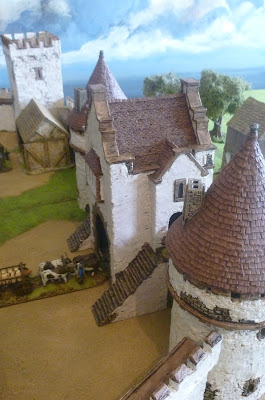The 3D printing theme continues today with a great new addition to my northern European fortifications, a large fortified gatehouse. Just reading a few of the battle reports on this blog should indicate how regularly these walls and towers feature in my games. I am always keeping an eye out for new pieces to add to the collection and have the right feel for the period. I found the above gatehouse available as a 3D print on ebay and thought it looked so good I took a risk of ordering it without knowing if it would fit in well with my existing walls of towers. Luckily it fits perfectly as can be seen in the photos below.
The gatehouse reminds me of woodcuts of the early 16th century such as those in "Der Weisskunig" or Maximilian's Triumphal Arch. A couple of images from each are shown below to demonstrate this. I have no doubt that many of these are simply the artists impressions but they are close enough to this model to really help give the correct feel.
 |
| A woodcut image by Wolf Traut from Maximilian's Triumphal Arch, 1512-1515 depicting Maximilian's war in Flanders. Note the gatehouse in the top right. |
 |
| Another woodcut from the Triumphal Arch, this time by Hans Springinklee, depicting Maximilian quelling a rebellion in the Low Countries. A similar gatehouse can be seen at the top of the image. Also of interest is the clothing and armour of the Flemish rebels shown to the bottom right of the image. |
 |
| A woodcut from "Der Weisskunig", 1514-1516, showing a similar style of gatehouse. |
 |
| Another woodcut from "Der Weisskunig" showing an army entering a massive fortified gate. |
Of course I couldn't simply paint up the 3D printed model without some changes. It needed to be able to fit in with my current set of northern European walls and so it has had a thin covering of filler to act as the plaster before being painted. The whole set was redone back in 2019:
http://camisado1500s.blogspot.com/2019/09/repainted-fortifications-part-1.html and I still wonder whether I should've just left them all with a stone finish. I feel this is one of those projects where I will never be completely satisfied either way. Since repainting the walls and towers of this particular set they have been used in games to represent parts of Exeter, Edinburgh, Belgrade, Bray, Buda, Nuremburg, Neufchateau, Ferniehurst, Waterford, Wark, Montdidier, Carlow, Saint-Quentin, Sluys and Stuhlweißenburg as well as unnamed Irish and Scots tower houses so I guess flexibility is key!
The other change made to the original printed model was to add some extra windows from Firedragon Games:
https://www.firedragongames.co.uk/materials/windows. I felt that to add to its defensive capabilities the gatehouse needed more windows from which the defenders could shoot and these have been added to the front and sides. The arrow slit windows at the front have had the bottom part of the window enlarged to turn it into a gun port for smaller calibre artillery. As the architecture of the gatehouse is distinctly late medieval I do wonder that it may have been the type of fortification that would have been built with more up to date gun ports. As always these things are a work in progress and I may modify the gatehouse in the future.
 |
| A force of landsknecht march out of the gatehouse. |
 |
| A northern European gatehouse in the early 1500s. |
 |
| A view of the gatehouse from the other side. |
 |
| The town facing side of the gate. |
 |
| Note the additional window added to the side of the gatehouse. |
 |
| The gatehouse with a harbour beyond it. |
 |
| Internal detail of the gatehouse looking up towards the first floor and second floors. |
 |
| Internal detail of the gatehouse showing the gate with wooden platforms on either side which are reached from the walls. |
 |
| Internal detail showing one of the doorways onto the walls with a staircase on the right leading to the second floor. The top of the gate can be seen on the left. |
Another feature of the gatehouse is that it is fully detailed inside. The gate opens up into a hallway with wooden walkways on either side that lead to the walls. From these walkways there are steep wooden stairs that then lead up to a second floor. Hopefully the three photos above capture this.
As a final note any gatehouse needs guards and with this year's reenactment season nearly over I have included some pictures of myself as a potential member of the garrison! These pictures were taken at Bosworth last month after my friend Phil picked up a second hand 350lb crossbow. I couldn't resist borrowing it to pose as a late 15th or maybe very early 16th century crossbowman.
 |
| Maybe one of the town's garrison? A crossbowman. |
 |
| A classic loading the crossbow pose! This is a 350 pound bow and not easy to load. |




























